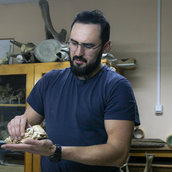Paleontologists Unearth 2.5 Million-Year-Old Camel Skull in Tajikistan
Paleontologists from Russia and Tajikistan have discovered a unique find in the Kuruksay Tract (Tajikistan) – the skull of an ancient camel of the Trofimov period of the early Pleistocene (2.5 million years old). The whole skull is a great success, because mostly parts of the skull or bones are found, and the skull of a camel of this particular species has not been found before.
“We are very lucky because bones all over Asia are poorly preserved, even those that are only 2,000 years old. They are like chalk on the inside, extremely fragile. If you accidentally touch a bone without first treating it, it will crumble into small pieces. We had to impregnate the skull with a glue solution. We waited for the glue to dry, and then we continued with the cleaning. We worked with a scalpel, a small brush, very slowly. This is real paleontology, like digging up dinosaur bones. That is why my colleague Vadim Titov, a specialist from Rostov, spent four whole days cleaning the skull,” says Dmitry Gimranov, a senior researcher at the Laboratory of Natural Science Methods in Humanities of the Ural Federal University and the Laboratory of Paleoecology of the Institute of Plant and Animal Ecology of the Ural Branch of the Russian Academy of Sciences.
At the excavation site, the skull was completely glued and fixed with a film. This allowed the find to be taken to the Urals for restoration and study (for three years, then the skull will be returned to Tajikistan for further research). The skull was transported in a box in hand luggage, otherwise it could have been damaged, explains Dmitry Gimranov. However, the front part of the skull fell off anyway.
“Right now the skull weighs almost 20 kilograms, because inside the loess is sedimentary rock, similar to heavy, hard clay. It will take a long time to unpack – we will open the film piece by piece, see which part is lagging behind, pour glue there, and wait. The unpacking process can take several days,” adds Dmitry Gimranov.
The skull will provide paleontologists with a lot of important biological information: from what exactly this species of camel fed on, to how much sexual dimorphism was expressed (how males differed from females), to what the brain volume was, how the neck muscles were attached, and much more. This will require dissecting the skull, taking a CT scan, and looking at the structure of the brain, nasal parts, and teeth.
“In terms of size, the skull of the ancient camel is almost the same as that of its modern cousin, the one-humped camel. But we definitely need to study the teeth. All camels have strong canines, but the size of the teeth in the ancestral form and modern individuals may be different, and the structure of the teeth is likely to be different. This is the visible evolution,” Gimranov adds.
The teeth may be different because ancient camels were adapted to a different lifestyle and diet, experts explain. Researchers believe that 2.5 million years ago, the territory of Tajikistan was not a dry desert, but savannah-like landscapes (the climate is roughly similar to today’s North Africa).
“There are no reconstructions of this camel today, as there are of most ancient Eurasian camels. We can judge the lifestyle of the ancient camel by the general appearance of the fauna and the region. The early Pleistocene was characterized by savannah-like landscapes. There are no obvious desert or semi-desert species in the Kuruksay fauna. On this basis, I believe that Early Pleistocene camels did not need to grow their humps because they lived in quite comfortable conditions. That is, these ancient camels did not have humps simply because they did not need to store nutrients for a long time,” says Vadim Titov, co-author of the discovery and a leading researcher at the Federal Research Center of the Southern Scientific Center of the Russian Academy of Sciences.
The fact that the climate on the territory of Tajikistan was different is proved by the accompanying findings that paleontologists discovered in the Kuruksay tract. Along with the skull, they found bones of a giant short-faced hyena (Pachycrocuta), Lynx issiodorensis, Etruscan wolf (Canis etruscus) and rhinoceros (Stephanorhinus etruscus), raccoon dog (Nyctereutes procyonoides), sabre-toothed cat (Smilodon), steno-like horse (Equus stenonis), several species of deer, antelope and gazelle.
“Active paleontological work in the Afghan-Tajik territory – one of the largest areas in Central Asia, where Pliocene and Quaternary sediments accumulated due to the destruction of intensively growing mountain structures of Hissar, Darvaz, Pamir and Hindu Kush – has been carried out since the 1960s. At that time, scientists discovered several rich Late Miocene (10 million years old) and Early Pleistocene (2.5 million years old) sites, including the Kuruksai tract near Boljuwan, where we conducted our work. Today, the tract is the best known site of Early Pleistocene fauna in Tajikistan. We have made amazing discoveries here: new species of large ungulates, trunks, predatory mammals. But no one had ever found a complete camel skull. Of course, for paleontologists, a whole skull is much more valuable than individual teeth, jaws or bones,” says Rustam Muratov, head of the Department of Terrestrial Vertebrate Ecology at the Pavlovsky Institute of Zoology and Parasitology of the Academy of Sciences of Tajikistan (Dushanbe).
Paleontologists from the Institute of Plant and Animal Ecology of the Ural Branch of the Russian Academy of Sciences, the Ural Federal University, the Southern Scientific Center of the Russian Academy of Sciences, and the Donish Institute of History, Archaeology and Ethnography of the Academy of Sciences of the Republic of Tajikistan participated in the expedition.

